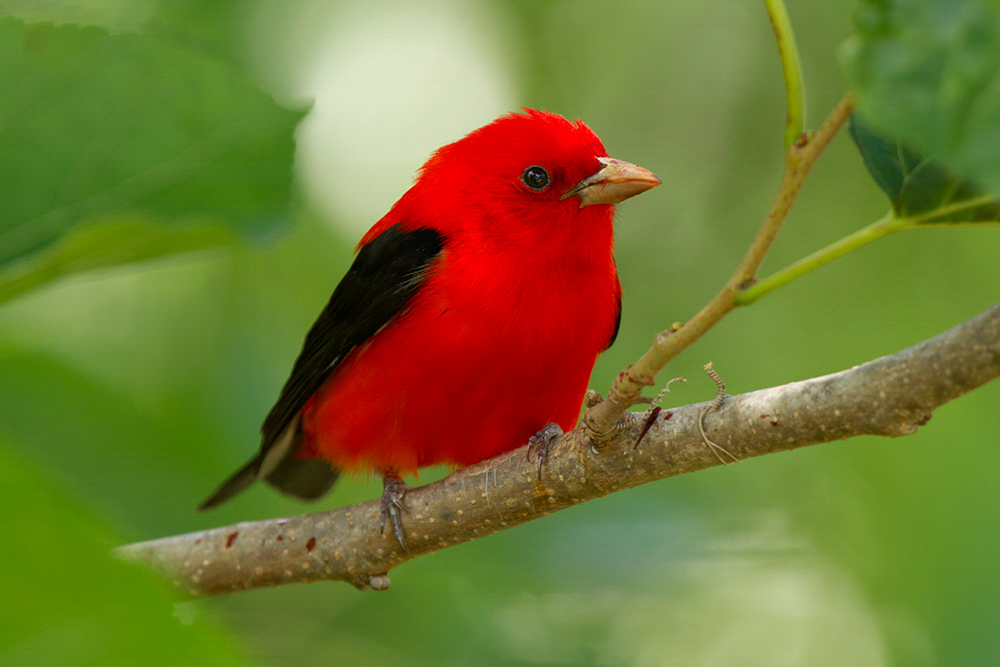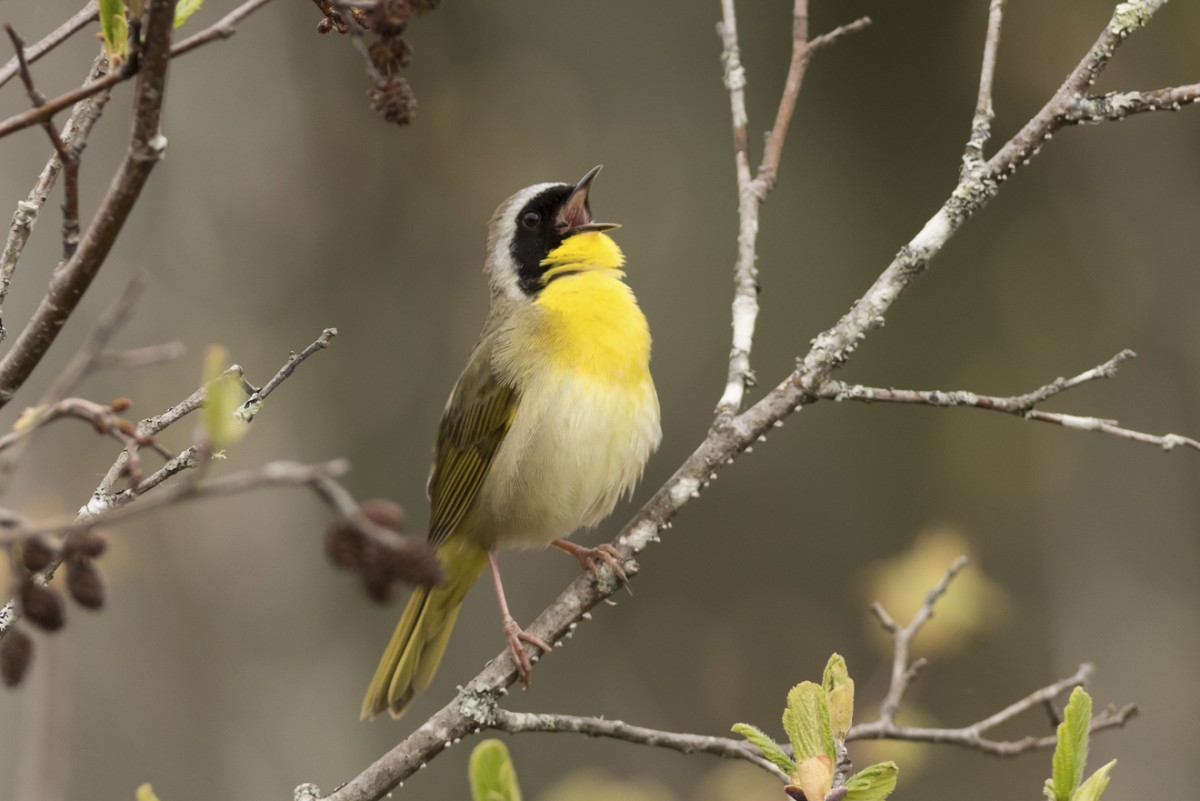November 2007
Global warming a hot topic— The recent announcement that this year’s Nobel Peace Prize will be awarded to former US Vice-President Al Gore and the United Nations’ International Panel on Climate Change has kept the focus on this overarching environmental issue. Climate change is being discussed by presidential candidates, foreign leaders, the general public, and perhaps most importantly, state and federal legislatures.
Nearly every aspect of life on earth will be affected by global warming, and nearly all for the worse. Of great concern to Auduboners is the changes it will bring to birdlife. The American Bird Conservancy and the National Wildlife Federation have joined forces to produce a comprehensive report on songbirds, including a state-by-state analysis if current trends of greenhouse gas emissions continue.
The list of species that may disappear completely from NY State includes such common birds as Least Flycatcher, Bank Swallow, Red-breasted Nuthatch, Winter Wren, Sedge Wren, Blue-headed Vireo, Magnolia Warbler, Yellow-rumped Warbler, Black-throated Green Warbler, White-throated Sparrow, Dark-eyed Junco, Purple Finch and Northern Cardinal, among many others.
The early signs of this trend are already being seen. For example, a pilot study of 35 North American warbler species found that the range of 20 percent of the species has shifted significantly north in the past 24 years. This is consistent with what would be expected as birds seek climates to which they are adapted.
Some species may face extinction from these changes. Scientists believe the already-at-risk Bicknell’s Thrush, which has a remnant population in NY State, and depends on high-elevation spruce/fir forests for breeding habitat, may disappear as a result of global warming.
What you can do — At the state level, Gov. Eliot Spitzer this summer vetoed legislation to create a Climate Change Task Force. The governor has not taken the bold steps needed to face up to global warming. Let him know NY must take action now. Gov. Spitzer needs to:
- issue regulations to implement the Regional Greenhouse Gas Initiative, a ten-state pact to cut emissions from the region’s power plants, and increase investment in clean energy and efficiency
- establish an economy-wide cap on carbon dioxide emissions the way California and other states have done
- allow more consumers to sell their excess electricity back to the grid, or “net meter”
- eliminate state subsidies that encourage wasteful uses of energy, such as the state’s flawed “Power for Jobs” program (a pet project of local State Sen. James Seward)
- amend the regulations related to the State Environmental Quality Review Act to require a review of projects’ contributions to climate change
- help convince Congress to raise automobile fuel efficiency standards
In line with the last recommendation, the US Congress has energy legislation and anti-global warming measures on its docket. Both houses have passed versions of an energy bill which now must be reconciled in conference. This is wide-ranging, complicated legislation, but our US Senators and Representatives should push for keeping the renewable electricity standard in the House bill, keeping fuel economy improvements in the Senate bill, and improving the biofuels provisions in the Senate bill.
Congress is also gearing up for legislation aimed specifically at reducing global warming. Key committees are in the initial stages of drafting cap & trade legislation that would limit overall emissions of global warming pollution, primarily carbon dioxide, and reduce the amount of emissions over the next several decades.
Again, our federal representatives need to hear that this is an important issue to us. They likely don’t have bird and other wildlife impacts from global warming in mind, and it is our job to let them know!
October 2007
Important farm legislation pending in Washingon— One of the most critical pieces of environmental legislation in Washington is often not even recognized as such by the public. The Farm Bill — typically reauthorized every 6 years by Congress — includes many provisions affecting farming practices, land and water conservation, and habitat for wildlife. All of these have impacts on birds and other wildlife, as well as the quality of our environment.
For example, three programs, the Conservation Reserve Program (CRP), the Wetlands Reserve Program (WRP) and the Wildlife Habitat Incentives Program (WHIP), will help conserve tens of millions of acres of private land. These programs, and others, offer outstanding habitat for migratory birds and waterfowl. While much of the land in these programs is in the Midwest, farmers in NY State also take advantage of them.
The Farm Bill’s land conservation programs are administered by the Natural Resources Conservation Service (NRCS). The NRCS offers full professional support — including biologists, hydrologists, soil scientists, and more — to landowners, and helps them with the enrollment process: deciding which programs to apply for, writing restoration plans, and even assisting with the actual applications. The House of Representatives passed its version of the Farm Bill this summer. Although it did not include the full funding for conservation programs sought by environmental groups, it did increase overall funding for conservation of bird and wildlife habitat on private lands. The House did reauthorize the Grasslands Reserve Program (GRP), a program essential to protect and enhance habitat for grassland birds, many of which are in rapid decline. The Farm Bill now faces action in the US Senate and then reconciliation between the two bills. Hopefully it can be strengthened in the Senate to maximize its environmental benefits over the next few years.
What you can do — Contact NY’s US Senators Charles Schumer and Hillary Clinton and urge them to advocate for strong conservation programs in the 2007 Farm Bill. Both senators are well-aware of the legislation’s importance to farmers, and they need to give at least equal weight to the concerns of conservationists and the land, water and wildlife protections the Farm Bill can provide.
September 2007
Renewables move ahead in Washington—
Last month the US House of Representatives passed a broad energy bill which included a ground-breaking amendment increasing the nation’s use of renewable power, and improving energy efficiency.
The amendment, sponsored by Reps. Tom Udall and Todd Platts, would require 15% of America’s electricity to come from sources such as wind, solar and biomass or enhanced efficiency by 2020.
Experts say that the US can meet and exceed that goal with existing technologies. In addition, recent studies by the Union of Concerned Scientists found that increasing renewables and efficiency will generate high-paying jobs in manufacturing, construction and more. Due to the reduced demand for fossil fuels, the changes will save consumers on their electric and natural gas bills.
The legislation will establish a renewable energy standard requiring utilities to gradually increase the amount of renewable energy they use to generate electricity each year. It creates a market-based mechanism of tradeable renewable energy credits – similar to the Clean Air Act trading system – allowing utilities to meet the requirements at the lowest cost.
Twenty-three states, including New York, currently have renewable standards, but involvement by the federal government provides a more level playing field for utilities, and broadens the movement away from coal and other polluting fuels.
The House bill also provides funding for alternative energy and efficiency programs. Environmentalists hoped the House would increase automobile and truck fuel mileage standards, but this failed due to opposition from automakers. Supporters vow to press this issue when Congress reconvenes.
What you can do — The energy legislation was supported by local Representatives Michael Arcuri, Kirsten Gillibrand, Maurice Hinchey and Michael McNulty. A note of appreciation to them for their vision of a cleaner energy future for the nation is certainly in order.
The House bill must be reconciled with Senate legislation. New York’s US Senators Charles Schumer and Hillary Clinton are generally supportive of environmental issues, but cannot be taken for granted. In addition President Bush has threatened a veto if the energy bill does not increase oil, gas and coal production. They should be contacted and urged to support renewable energy.
June 2007
Make polluters pay for natural resource damage —
It has long been a common sense principle in environmental law that anyone polluting a public natural resource such as a waterway should bear the costs of cleaning it up. The federal Superfund law and other statutes are based on this “polluter pays” concept.
However, in New York there are limitations on the ability of the state to recover costs of such cleanups. Currently the state can recover damages only in the case of petroleum spills as defined in the Navigation Law, or by bringing an action for damages under federal law, which is time consuming and provides a short statute of limitations. Recently introduced legislation would improve this situation by creating a liability for natural resource damages and providing for recovery of damages. It also provides for enforcement and penalties for violations and establishes a position of Natural Resources Trustee to act on behalf of the people of the state when public resources are damaged. The bill would also establish a New York Natural Resource Revolving Trust Fund to be used for restoration of damaged natural resources, and empower the Attorney General to obtain liens against real property held by non-compliant responsible parties.
What you can do — Contact your state Assembly member and ask them to cosponsor and support A.8090. Tell your state Senator that those responsible for damaging public resources should pay for the damages, not be allowed to walk away. Also note that for this law to succeed, the Department of Environmental Conservation needs adequate staff to carry it out.
Energy in Washington: not all alternatives are equal —
The US Senate Energy and Natural Resources Committee has passed legislation to increase use of biofuels in the United States. This legislation is expected to be turned into a larger energy package that may be voted on by the Senate in early June.
Biofuels such as corn-based ethanol may have a role in reducing dependence on fossil fuels, but they have their own set of problems such as pesticide and fertilizer use, pollution, and conversion of large amounts of land to monocultures. In addition, they typically use large amounts of energy to produce, significantly reducing their benefits.
Much preferable as energy policy are improvements in energy efficiency of lighting and appliances, and increased fuel efficiency standards for motor vehicles. Efficiency standards in the European Union and Japan are nearly twice those of the US. Another controversial issue, The Senate needs to include efficiency standards in any energy legislation.
What you can do — Ask Senators Hillary Clinton and Charles Schumer to work for conservation as the Senate debates an energy package in the coming weeks. Efforts to produce biofuels and alternative petroleum-based fuels provide less bang for the buck and only a fraction of the global warming benefits of efficiency improvements.
May 2007
Good lineup of Earth Day bills —
The State Legislature completed its budget nearly on time this year. This means that the Assembly and Senate have time to work on serious legislation before adjourning in June.
There is a good chance for action on several important environmental bills this session. All have bipartisan support, but have been kept from a vote by Senate leaders. This is unfair to rank and file legislators and the public alike. We need to let our local State Senators James Seward and John Bonacic know that blocking this worthy legislation is no longer acceptable.
Among the bills promoted for Earth Day this spring are:
- Climate Change Solutions Act – A.7365 (Sweeney) and Climate Change Solutions Fund – A.7366 (Gianaris). These bills would increase the state’s support of energy efficiency and renewable energy programs, important steps in reducing the emissions of greenhouse gases that contribute to global warming.
- Bigger Better Bottle Bill – S.3434 (LaValle). Overdue for passage, this legislation would add water and juice containers to the current law putting deposits on carbonated beverages. It would also put unclaimed bottle deposits into the Environmental Protection Fund for such projects as open space protection and recycling programs.
- Community Preservation Act – A.7333 (Sweeney) / S.3836 (Marcellino). This bill is particularly well-supported by legislators, local governments and the public. It would give local municipalities the option to add a small surcharge to large real estate transfers in order to fund community natural and historic resource protection programs.
- Wetlands Protection Act – (A.7133 (Sweeney) / S.3835 (Marcellino). A court decision has left NY’s smaller wetlands unprotected under federal law. This loophole allows wetlands as large as 12 acres to be destroyed with no oversight. This legislation would extend state authority to protect wetlands as small as one acre. These areas provide flood and drought control, as well as important wildlife habitat.
What you can do — Contact your legislators, particularly your State Senator, and let them know that you support this legislation, and insist that it be brought up to the floor for a vote this session. The time for delay on these bills has ended, and the Senate’s behavior has to change.
Climate change action in Washington also —
The past few months have brought increasing attention to the issue of climate change, or global warming. Release of the movie An Inconvenient Truth, along with damning reports from the United Nations, have brought public focus to this worldwide threat to humans and wildlife.
The Bush administration continues its head-in-the-sand approach to the issue, but Congress has put forth strong legislation to move the US, the greatest contributor to global warming, onto a path of significantly reducing greenhouse gases over the next 5 decades.
Rep. Henry Waxman of California has introduced “The Safe Climate Act”, along with over 120 cosponsors. The bill would gradually reduce emissions to 80 percent below 1990 levels by 2050. The legislation would cut emissions from sources such as cars and power plants at the levels needed to avoid the worst effects of global warming.
Similarly, in the Senate “The Global Warming Pollution Reduction Act” has been put forth by Sen. Bernie Sanders of Vermont and Environment and Sen. Barbara Boxer of California. As with the Waxman bill, emissions would achieve the same reductions by 2050.
These are ambitious goals, but experts are nearly unanimous in their opinion that such limits are our only chance to halt severe climate change in the future.
What you can do — Let our Representatives and Senators in Washington know that global warming is an overriding issue that has environmental, security, economic and social ramifications for the US and the world. We need action now – not in 10 or 20 years. Ask them to cosponsor these bills and push for their passage.
April 2007
Budget time in Albany – help needed for DEC —
NY Governor Eliot Spitzer’s first executive budget bodes well for his commitment to the environment. Among the most important inclusions were 109 badly needed positions in the state Department of Environmental Conservation. The Pataki administration had regularly cut DEC staff, leaving critical shortages in many areas of the agency, including permit reviewers, biologists, and rangers and conservation officers. It is estimated that DEC lost 800 positions under Gov. Pataki, jeopardizing the agency’s ability to carry out its mission. Gov Spitzer has proposed adding these staff, as well as establishing a brand new Office of Climate Change to guide the state’s role in the country’s first-ever regional climate pact. Note that these are not bonus or extra positions; they are critical to protecting NY’s environment and public health and safety. They will help ease the backlog of projects and work that had fallen by the wayside in recent years.
The state Assembly agreed with the Governor’s assessment of DEC’s personnel needs, including all 109 positions in its proposed budget. However, the state Senate cut this in half, continuing DEC’s staff shortfall. As the budget is hashed out in Albany, the Senate needs to know that DEC has been short-changed for too long.
What you can do — Contact your state Senator and urge that the DEC positions be fully funded and that the agency be empowered to do the important work of keeping the state’s land, air and water clean.
Environmental Advocates has a prepared email letter to Senators on this topic. Visit their website to learn more.
Truly protect the Arctic National Wildlife Refuge —
As Auduboners are well aware, one of the hardest fought and longest environmental battles of recent years has been the effort to keep oil companies from exploiting the pristine Arctic National Wildlife Refuge (ANWR).
To date, this battle has been successful, but our side has come within a hair of losing this irreplaceable ecosystem to drilling on more than one occasion. In addition, it has repeatedly required the time, energy and money of conservation groups and their members to hold the pro-drilling lobby at bay.
This January, the Udall-Eisenhower Arctic Wilderness Act (HR 39) was introduced in the House. The bill would “preserve the coastal plain of the Arctic National Wildlife Refuge as wilderness, in recognition of its extraordinary natural ecosystems and for the permanent good of present and future generations of Americans.”
By designating ANWR as wilderness, its legal protections will be enhanced, making it more difficult for the drillers to gain access to the refuge. There is no question that these lands are wilderness. When the refuge was originally established as part of the Alaska Lands Act decades ago, wilderness designation was withheld only because of the need to achieve a political compromise to get the bill approved.
The current legislation has 123 co-sponsors, but neither of our new US Representatives, Kirsten Gillibrand nor Michael Arcuri, is on this list. For ANWR to receive the protection it needs and deserves, a strong showing from the Democratic Majority in Congress is needed.
What you can do — This is an excellent opportunity for these newly elected lawmakers to make a difference in Washington on an important issue. Contact your representative in Congress and ask them to cosponsor HR 39, and protect ANWR for future generations.
March 2007
Florida – can it be saved? —
I’m writing this from warm, sunny Florida – a wonderful place for a winter vacation. The lush, tropical foliage, the exotic birds, the white beaches and blue water all make this state a paradise, especially for us northerners.
Florida is also a land of sprawling housing developments, malls, roads, and industrial agriculture. It’s hard not to think how much more of a paradise it must have been only 100 years ago.
There may be a more human-altered large ecosystem than Florida, but I’ve never encountered one. The Everglades alone represents major degradation of a vital wild area. Originally covering the lower third of the Florida peninsula, the Everglades was a broad wetland of slow moving shallow water that provided habitat for a wide variety of plants and animals, including huge populations of birds. Through the 20th century, this ecosystem suffered drainage projects, filling, clearing and construction that fundamentally changed its delicate hydrologic balance. Excess nutrients entered the Everglades from intensive agriculture and development around its edges. Droughts led to damaging fires, and invasive species pushed out natives.
At its low point, populations of Everglades wading birds dropped to 10% of their original levels. Lake Okeechobee, at the head of the system, was a weed-choked basin of eutrophication. Mangroves at the tip of the Everglades were dying from changes in salinity and pollution of the brackish water.
Finally, the damage and threats to the Everglades were recognized by all parties in Florida, and a large restoration effort is underway. The goals include returning water flows to their historic levels and timing through Lake Okeechobee and into the “river of grass” as the Everglades is known. Also, nutrient levels will be controlled, waterways de-channelized, and existing undeveloped lands protected.
This is a daunting effort though, involving local, state and federal agencies, development and agricultural interests, as well as environmental organizations such as Audubon. The support of Congress and the administration is critical, as much of the restoration funding will come from Washington. The Everglades will never be what it was a centruy ago, but there is cautious optimism that its decline can be halted and perhaps reversed.
The Everglades are not the only exploited area of Florida by any means. As with most coastal areas, beachfront and barrier island development pressure is intense, and even the threats and realities of tropical storms do not seem to hold it back. Further inland, large areas of palmetto/pine scrublands have been bulldozed for agriculture, endangering such species as the Florida Scrub Jay and Gopher Tortoise. Fire suppression has altered the remaining shrublands and prairies, reducing their value for native wildlife. Now residential development is moving away from the coasts as Florida’s population influx continues.
There are bright spots however. Formerly endangered species such as Bald Eagle, Osprey, Brown Pelican and American Alligator appear to be prospering. Wood Storks, though still endangered, are more numerous and widespread, and egrets and herons are common and have adapted even to developed areas. A project to establish a migratory flock of Whooping Cranes has made it possible to spot these spectacular birds on occasion.
There seems to be a recognition of the need to save what is left of Florida’s wilderness, if not for its own value, to preserve diminishing water supplies and the quality of life residents enjoy. The state is on the cusp – there are still fortunes to be made in development, and only public pressure and political will can resist these forces.
What you can do — Urge your federal representatives to support funding for Everglades restoration in the US Army Corps of Engineers budget. Remind them that Everglades restoration projects are already behind schedule and that costs increase each year of delay.
Contact Florida Governor Charlie Crist and ask him to push the 50:50 state/federal partnership to implement the $8 billion Comprehensive Everglades Restoration Plan. If you visit Florida, tell him that his state’s natural values are important to you, and that statewide environmental restoration efforts are needed.
Gov. Charlie Crist
Office of the Governor, The Capitol, Tallahassee, FL 32399-0001
Phone: (850) 488-7146
Fax: (850) 487-0801
February 2007
Polar bears taking the heat —
Of all the species at risk from global warming, perhaps none is in more peril than polar bears. This animal, which defines the Arctic regions for many people, is inxtricably entwined with the now rapidly shrinking ice cap.
The bears use ice pack and ice floes to hunt for seals, their primary food. They are able to swim long distances, but in recent years polar bears have been found drowned when unable to find floating ice. Also, warmer temperatures have delayed ice cover as much as a month longer than normal in some areas, leaving bears malnourished and underweight. Instances of cannibalism among hungry bears have been reported.
Of the world’s nineteen populations of polar bears, at least five are considered in decline. The World Conservation Union (IUCN) is predicting a 30% reduction in polar bear numbers in the next 45 years. In Alaska, polar bear birth and survival rates are dropping as their hunting opportunities become limited.
Warming temperatures are not the only threat polar bears face. Increasing levels of pollution in the Arctic are disrupting their hormones, and the risk of oil spills from drilling and transportation is always present in Alaska, Canada and other areas.
The drop in polar bear numbers has prompted the US Fish & Wildlife Service to propose listing them as a threatened species under the Endangered Species Act. Such listing would not reverse climate change, but federal regulatory agencies would be required to consider how their decisions affect the habitat and longevity of the polar bear. The listing would also enable state and federal wildlife managers to curb other causes of polar bear decline, such as unsustainable hunting and chemical exposure.
What you can do — Let the Fish & Wildlife Service know that you support their efforts to protect polar bears. They are presently receiving comments on the threatened species listing. Submit comments to: Supervisor, U.S. Fish and Wildlife Service, Marine Mammals Management Office, 1011 E. Tudor Road, Anchorage, Alaska 99503, or by email. Send copies to your federal representatives to encourage their support for this proposal.
Help keep Oneonta’s Southside bike and pedestrian friendly —
Over the past few years, the NY State Department of Transportation has been planning traffic changes to the commercialized section of Southside Oneonta and the Lettis Highway entering the City of Oneonta. Although the design has not been finalized, it is expected that additional lanes will be added to allow more cars to move through the corridor.
Unfortunately, this is a flawed approach to traffic congestion. Studies have consistently shown that adding more capacity for vehicles just brings even more cars. This “induced traffic” quickly overwhelms the wider roads and recreates the problem. In addition, DOT is now backing off from its promise to include sidewalks and bicycle lanes in the project design.
There are already walkers and bikers who travel to the Southside from the city, and their numbers could be increased with safe, convenient walkways and bikeways. At the original public hearing on the Southside Corridor project, DOAS submitted comments encouraging imporvements for non-vehicular access and improved mass transit as alternatives to bringing in even more cars to an already overcrowded commercial strip.
Development on the Southside has already cost Oneonta a wonderful floodplain forest that was cleared and filled to make way for the Hannaford supermarket and adjacent stores. In addition, the Town of Oneonta has allowed inappropriate construction nearly up to the banks of the Susquehanna River. Bringing in more traffic will only make a bad situation worse.
What you can do — Write the DOT project manager and insist that the agency create a forward-looking and pedestrian- and bike-friendly design for the Southside. This is an opportunity for Oneonta to be a model for healthier, safer and cleaner transportation alternatives. Send comments to: Mr. Peter Larson, Project Manager, Reg. 9, NYS Dept. of Transportation, 44 Hawley St., Binghamton, NY 13901.
Follow up to Roadless Rule court victory —
Last month we noted that US District Court Judge Elizabeth LaPorte had provided environmentalists a major victory in September when she ruled that the Bush administration had illegally repealed the Roadless Rule for National Forests. The Roadless Rule protected 58.5 million acres of roadless areas in National Forests and Grasslands from most logging and road construction.
On Nov. 29, Judge LaPorte strengthened her decision by ruling that work already begun under the Bush administration’s rollback of the rule must be halted. The US Forest Service argued that these projects and timber sales were started in good faith, but the judge did not agree and issued an injunction halting road building associated with oil and gas drilling on inventoried roadless areas in 14 national forests, mostly in the Rocky Mountains. The order also halts construction of two miles of new roads through the Borah Peak roadless area in Idaho’s Salmon-Challis National Forest.
Report documenting global warming impacts in NY released —
In late November, Environmental Advocates of NY issued a report on the anticipated effects of global warming on our state’s public health, economy, agriculture, water supply and other areas of our society. Environmental Advocates, of which DOAS is a long-time member, is the state’s premier Environmental organization and is to be commended for preparing this important study.
Forecast for New York: Projected Global Warming Impacts & Next Steps looks at numerous souces in drawing its conclusions, including recent climate projections that show substantial changes for NY. These include higher annual temperatures, more extreme heat days, sea level rise, declining snow cover, more frequent floods, and increased drought. These projections indicate that without significant reductions in greenhouse gas emissions, NY’s weather will resemble that of Georgia and South Carolina by the end of this century.
Public health impacts of global warming include heat stroke, increases in asthma and other respiratory illness, and infectious and vector-borne diseases. Estimates are that summer heat-related deaths in NY may increase between 50 and 200 percent.
Wildlife will also be affected. The state may lose over 30 species of songbirds in summer, and the ranges of another 20 could contract significantly. Duck populations are forecast to decline 19-39% by 2030. Invasive species, particularly those from warmer climes, can be expected to increase and expand, further stressing native plants and wildlife.
The report makes clear that NY will be profoundly affected by global warming in all areas of our environment and society. The full report is available here.
What you can do —
The Environmental Advocates report makes a number of recommendations to lessen or eliminate the anticipated threats from global warming. Among these are:
- establishing more aggressive statewide greenhouse gas emissions limits for all economic sectors,
- creating a statewide standard so that electricity demand growth is met by projects that increase NewYork’s overall energy efficiency,
- establishing a permanent Climate Change Commission responsible for establishing an emissions baseline, evaluating policies, and making recommendations for future actions,
- auctioning 100% of the CO2 emission allowances envisioned under the Regional Greenhouse Gas Initiative in NY, a seven-state plan to cut carbon dioxide emissions from electic power generators in the Northeast.
Contact your state representatives and ask them to redouble NY’s commitment to reducing greenhouse gas emissions. More renewable energy, stronger appliance and lighting efficiency standards, and cleaner transportation and industrial sectors are critical to the state’s future.
(Note that newly-elected state officials will take office January 1, 2007.)








